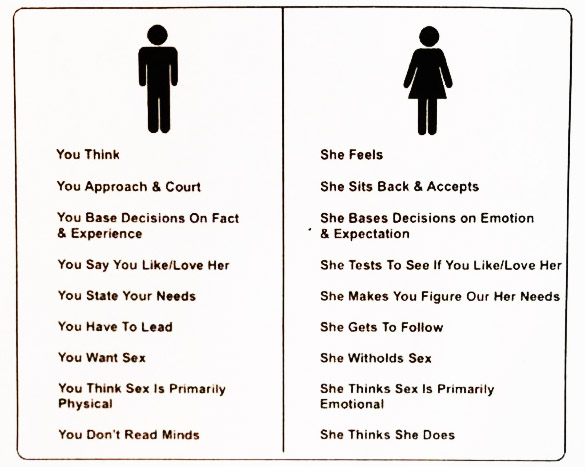From Reddit comes the story of an assignment given to high school students in a sex education unit of health class in Columbus, Ohio (as reported in the Dispatch).
The introduction reads (typos included):
Appreciating Gender Differences: Often there are many stereotypes attached to being male or female. Yet male and female together keep our species alive! Through knowing and appreciating the many differences in brain development and psychological processes of males vs. female one learn to accept and appreciate the differences.”
Then there’s this graphic:
Yes, boys and girls in the class all got the same handout, with the normal human described as “you” and the one in the dress labeled “she.”
After the graphic is a list of questions for the students to ponder in an essay, such as, “How might knowing these differences influence and impact an intimate relationship you might currently have or develop in the future?”
In her defense, the teacher naturally told the Dispatch that the point was to just “stimulate conversation.” But nothing in the assignment suggests the stereotypes might not be anything but true. None of the essay questions cast doubt on the facts presented.
Consider revising the text like this:
Appreciating Gender Similarities: Often there are many stereotypes attached to being male or female. Yet male and female together keep our species alive! Through knowing and appreciating the many similarities in brain development and psychological processes of males vs. female one learn to accept and appreciate the similarities.”
That could be a useful opening to a unit on gender and development for high school sex education (without the graphic).
Where did this come from?
The teacher said it came from “an outdated book.” With the power of Google image search, you can follow this image around the Internet, where it has been used by a lot of people to illustrate supposedly funny-but-oh-so-true stereotypes, like “Hilarious differences between men and women,” and on pages with sexist aphorisms such as, “A woman worries about the future until she gets a husband; a man never worries about the future until he gets a wife,” and on relationship advice pages, with conclusions such as, “If we understand this basic fundamental, there will be better relationships … steadier !!,” and even “Real, Honest Female Advice” for men who want to “start having unbelievable success with women.”
It always has the same typo (“Figure Our Her Needs”). I can’t find an original use, or any serious attempt at educational use, but I’d love to know who came up with it.


Reblogged this on iheariseeilearn.
LikeLike
Clearly this is how inequality begins. We teach every generation of men and women a standard, either with silence or with an social standard that accepts, condones and polices everyone’s behavior.
While both men and women choose based on expectation, experience, fact, emotion – there’s society out there telling them that there is a division among them that makes them diverse. There isn’t. Largely we’re all the same. We all both want and with hold sex, but for similar & different reasons. We all have tests we put the other one through. None of us TRUST IMPLICITLY. We trust based on fact, experience, reality. That leaves no room for expectation.
Clearly this is the worst type of “lets stimulate conversation” with adolescents who aren’t quite aware where the south end of a north bound mule is.
LikeLiked by 1 person
“Biology (e.g., one’s sex) is not destiny, but it’s a pretty good estimate of statistical probability”.
That is, “statistics drive stereotypes”.
I am so far to the effeminate side of “male” that before I aged out of the mating pool everyone just assumed I was gay, My favorite kind of woman was always ones that had sex drives that simply have no male equivalent, and were more sexually aggressive than any male would dare be on a college campus today. But I am a statistical outlier and so were the ladies who lit up my youth. It’s OK with me if my kids are taught our society’s norms. I don’t consider it “sexism” but “cultural literacy”. I just want them to feel as free to deviate from those norms as I always did.
LikeLike
Reblogged this on kissandtellx.
LikeLike
Reblogged this on uchechioma blog.
LikeLike